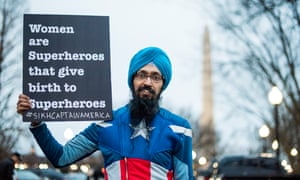Millions have done something together why the Womens March will spark the resistance

The weekends Womens Marches were historic events that showed the world the depth and passion of the anti-Trump movement. But we have to keep it going

On Saturday night, for Donald Trumps inauguration ball, police turned an entire grid square of Washington DC into a maze of fences, checkpoints and deserted roads, just to protect the partygoers. But even the cleverest maze has to have an entrance and it took just a couple of hundred peaceful but courageous protesters to block it. As a result, thousands of rich people had to thread their way across a square mile of wire and concrete in their tuxedos and taffeta.
I know it annoyed them because I walked with them. In the absolute silence, I could hear they were angry and afraid. They looked, collectively, like a George Grosz painting of the Weimar elite come to life.
And then, to annoy them some more, one out of every 100 people in America marched to reject Trumps project in its entirety. In the US, nearly 3.5 million people marched, the majority of them women, a huge proportion of them wearing pink, woolly pussy hats (There were marches against Trump in 20 countries around the world).
When a million people choke the transport system of a city, exchanging sudden and ephemeral chants, jokes and slogans with people theyll never meet again, it is the collective memory they establish that truly records the event. For people who were not there, the media records such events according to an established formula: a soundbite from Madonna, a wide shot of the crowd, a vox pop with somebodys grandma and finally a sceptic saying its all a waste of time. But events such as this alter peoples lives. They thrust big and complicated political questions into lives of routinely depoliticised people.

One woman, who flew from the west coast to attend, told me: I cant stand the colour pink, and that hat looks really shitty on me. But right now its my most precious material possession. Im betting there are lots of people out there who will look at their hats and remember that they need to do something not just today, but tomorrow and the next.
As they left the march, women in the underground stations passed round a phone number created to sign people up for action. Theres a big focus on the swingleft.org campaign, which aims to retake the House of Representatives by focusing on swing states in 2018.
But you would miss the historic significance of the Womens March if as with Trumps army of trolls you viewed it only through the frame of something called feminism or identity politics.
To comprehend the power of Saturdays demos, we have to understand the true nature of the threat Trump poses. The dominant trope in the US media is delusion. It says Trump is a charlatan, who will be restrained by the American constitution, tamed by office and gone in four years.
The importance of this delusion is that, for the liberal section of the US elite, it allowed them to justify continuity. They could go on ingesting the standardised prose of the New York Times, even though its editors were timid (according to its public editor) in the face of the emerging news story about Trumps links with Russia. They could cling to the fact that Hillary Clinton won the popular vote; that the Russians probably rigged the election. They could, above all, cling to the belief that US capitalism has turned a corner permanently, towards corporate social responsibility, equal opportunities and low-carbon energy.
But what Trump represents creates a split in the US business elite. And though he is not as the chant goes fascist, the dynamic between his white-supremacist misogynist mass base and the super-rich is playing out similarly to the way it did for Mussolini after 1922 and Hitler 10 years later.
The whiny old racist, in his hunting camouflage; the devoutly Christian housewife shouting obscenities at Hillary Clinton; the men in the tuxedoes yelping sore losers, snowflake and cuck at the protesters … they have all seen an illusion expire. The doctrine of manifest destiny tells them their nation was born to shape the world; the Presbyterian ideology of the founding fathers tells them that the individual is master of his fate. The crisis of neoliberal capitalism after 2008 has permanently cancelled both these dreams but the illusion lives, and must find an enemy to blame.

One of the many things that annoy authoritarian populists in the US, according to pollsters, are human rights. Human rights, to the rightwing middle classes, appear as privileges for other people: blacks, Hispanics, Native Americans, gay people and women, welfare recipients and trade unionised workers.
Hitler and Mussolini created armies of enraged middle-class losers because the bourgeoisie of Germany and Italy were too weak, powerless and hidebound by constitutional beliefs to act decisively against the perceived enemy (in both cases, it was above all communism and organised labour).
But once the efficacy of rightwing populism was proven, a section of the rich elite became all too willing to abandon constitutional democracy and go with the flow. Lest we forget, in both France and the US in 1934, there were serious, elite-backed attempts to overthrow elected governments, using millionaires cash and fascist street protests. Though not the weapon of choice of the corporate lawyer or property developer in his tuxedo, if offered the combination of a reactionary mass movement and a liar with a DayGlo tan, history suggests they will take it.
So the challenge for the truly liberal section of the elite is as in the 1930s what to do. If you work for a bank, a law firm, an Ivy League university or a Silicon Valley giant, and your employer is systematically accommodating the new, post-factual reality, you are even now, just weeks into the Trump era living a double life.
Whats good for the employer is to double down on the advantages of the new kleptocracy: fewer taxes, fewer climate oblig ations, fewer regulations on business and an 11-million-strong undocumented migrant workforce cowering in fear every time the doorbell rings.